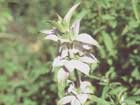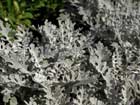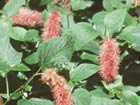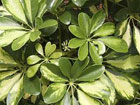Plant Profiles
Click on the first letter of the common name of the plant you wish more information about.
A | B | C | D | E | F | G | H | I | J | K | L | M | N | O | P | Q | R | S | T | U | V | W | X | Y | Z
D

Dogwood
Scientific Name: Cornus florida
Growth Habit: An upright to rounded deciduous tree growing to 30 feet tall and 20 feet wide. The leaves are oval and medium green with pronounced veins growing to 6 inches long and half as wide.
Light: Tolerates full sun but grows best with light shade.
Feedings: Feed lightly in March and June with a general garden fertilizer for the first three years after planting; thereafter, needed nutrients are supplied by the decomposing mulch and nearby feedings of shrubs and flowers.
Water Needs: Needs a moist soil; maintain a 3- to 4-inch mulch layer and water whenever the surface soil begins to dry.
Ease of Culture: Medium; needs more care than most trees to become established.
Propagation: Start plants from seeds or by grafting.
Hardiness: Hardy.
Major Problems: Dogwoods are difficult to establish in dry, sandy Florida soils. Improve planting sites with organic matter and keep moist. Borers affect the young branches and may have to be pruned from the trees. Powdery mildew and leaf spots may blemish the foliage, but controls seldom are needed.
Pruning: Train the trees to a single trunk, and keep the branches evenly spaced to form a symmetrical growth habit. Perform all pruning immediately after flowering during the spring to avoid affecting bud formation for the following year.
Uses: Dogwood trees bring back memories of northern landscapes, which many gardeners would like to re-create locally. They are used as accents near patios and along walkways. Dogwoods also can be planted as part of the backdrop for shrub and flower beds and under taller trees along property lines. Only the white-flowered dogwood grows locally. The variety Weaver's White appears to be one of the better selections for Central Florida, tolerating the hot, humid local growing conditions. Leaves and fruits provide fall color; the fruits are also a food for wildlife.
Florida Native: Yes.

Dotted Horsemint
Scientific Name: Monarda punctata
Growth Habit: An upright to sprawling evergreen perennial growing to 3-feet tall. The leaves are medium green, lancelike and aromatic, growing to 2-inches long and 1/2-inch wide.
Light: Plant in light-shade to full-sun locations.
Feedings: Plant in light-shade to full-sun locations.
Water Needs: Tolerates short periods of drought; grows best with a light mulch and weekly waterings.
Ease of Culture: Easy.
Propagation: Start plants from seeds or cuttings.
Hardiness: Hardy.
Major Problems: Susceptible to powdery mildew that often turns the leaves white during late spring and early summer. If needed, a fungicide can be applied for control. Chewing insects also may damage the leaves, but control seldom is needed.
Pruning: Plants can become gangly around midsummer as the flowers begin to decline. Prune to within a foot or two of the ground to encourage growth and fall blooms. Give the plants another renewal pruning in late February before spring growth.
Uses: An attractive addition to natural gardens, perennial beds and butterfly plantings. Horsemint produces a colorful inflorescence consisting of pinkish bracts that surround the white- to yellow-purple-dotted flowers May through October. The inflorescence remains attractive for a month or more. Plant as a backdrop for additional lower-growing flowers or use along walkways. Plantings attract butterflies and hummingbirds.
Florida Native: Yes.

Dusty Miller
Scientific Name: Senecio cineraria
Growth Habit: An evergreen perennial that is upright when young and spreads with age; grows to 2 feet tall and wide. The leaves are green with a thick covering of white to silvery hairs; the leaves are deeply cut to lacelike in appearance and grow to 6 inches long and half as wide.
Light: Plant in full sun to lightly shaded locations.
Feedings: Apply a general garden fertilizer monthly to in-ground plantings, every other week for container plantings.
Water Needs: Tolerates short periods of drought but grows best with weekly waterings.
Ease of Culture: Easy.
Propagation: Start plants from seed.
Hardiness: Hardy; survives all but severe winter freezes.
Major Problems: Dusty miller plants need a well-drained soil to prevent root rot problems. Plants decline during the summer rainy season because of excessive moisture.
Pruning: Trim as needed to keep leggy shoots in bounds. Many gardeners also remove the flower heads as they form during late spring to encourage branching.
Uses: Dusty miller is grown for its white to silvery foliage that forms an attractive contrast with red, pink purple and other plants with bright flowers. It's often planted in flower beds and container gardens with cool-season petunias, snapdragons and dianthus. Yellow flowers are produced in late spring but are of little interest to gardeners. Florida plantings of dusty miller are treated as long-lived annuals and are added to landscapes fall through winter. The plants are removed during early summer as they start to decline because of heat and excessive moisture.
Florida Native: No; native to the Mediterranean region.

Dwarf Chenille Plant
Scientific Name: Acalypha pendula
Growth Habit: A low-spreading evergreen perennial growing up to 6 inches tall and more than 2 feet wide. Dark green oval leaves growing 2 inches long and almost as wide with toothed edges forming along horizontal shoots.
Light: Plant in shade to filtered-sun locations.
Feedings: Apply a general garden fertilizer once in March, June and September. Feed container plantings monthly with a 20-20-20 or similar fertilizer.
Water Needs: Prefers moist soils; water at least weekly.
Ease of Culture: Easy.
Propagation: Start plants from cuttings.
Hardiness: Tender; damaged by frosts and freezing weather but often grows back from shoots near the ground in protected sites.
Major Problems: Occasionally damaged by chewing insects and mites but controls are seldom needed. Grow in a well-drained soil to prevent root rot problems.
Pruning: Trim plants during early March to remove cold damage and out-of-bounds shoots. Trim periodically during the growing season to prevent shoots from overgrowing walkways and creeping into nearby plantings. Keep the plants attractive by removing declining flowers.
Uses: Fill flower beds, open spots in foundation plantings and sites along walkways with chenille plants to develop a colorful ground cover. Strands of red flower clusters, called catkins, form March through November to contrast with the dark green foliage. Plants also can be added to hanging baskets and planters to display on shady patios and balconies.
Florida Native: No; native to Cuba.

Dwarf Schefflera
Scientific Name: Schefflera arboricola
Growth Habit: An evergreen upright plant that gradually grows to a rounded, multistem shrub more than 12 feet tall and wide in consistently warm climates. The shrub grows to about half this size in Central Florida. The leaves are compound, often more than 6 inches in diameter and consist of seven to nine dark-green to variegated segments.
Light: Plant in full sun to shade.
Feedings: Apply a general garden fertilizer to in-ground plantings every six to eight weeks March through October. Feed container plantings every other week with a 20-20-20 or similar product. A slow-release fertilizer also may be used following label instructions.
Water Needs: In-ground plantings tolerate short periods of drought but grow best with weekly waterings. Container plantings need a moist soil; water when the surface soil begins to dry.
Ease of Culture: Easy.
Propagation: Start plants from cuttings or air layers.
Hardiness: Tender; can survive frost and light freezes, growing back from stems near the ground.
Major Problems: Scale insects may affect the foliage and stems, causing leaf loss and general plant decline. Where needed, a natural oil spray can be applied.
Pruning: Remove the tips of new shoots as needed to encourage branching and full compact plants. In late February, remove cold damage and reshape the plants before spring growth.
Uses: Plants of solid green or variegated foliage are finding use as ground covers and foundation plantings in home landscapes. The unusual foliage adds the tropical look. Plants often are added to containers for patio, balcony and indoor displays. Plants occasionally flower, producing clusters of white blooms.
Florida Native: No; native to Taiwan.

